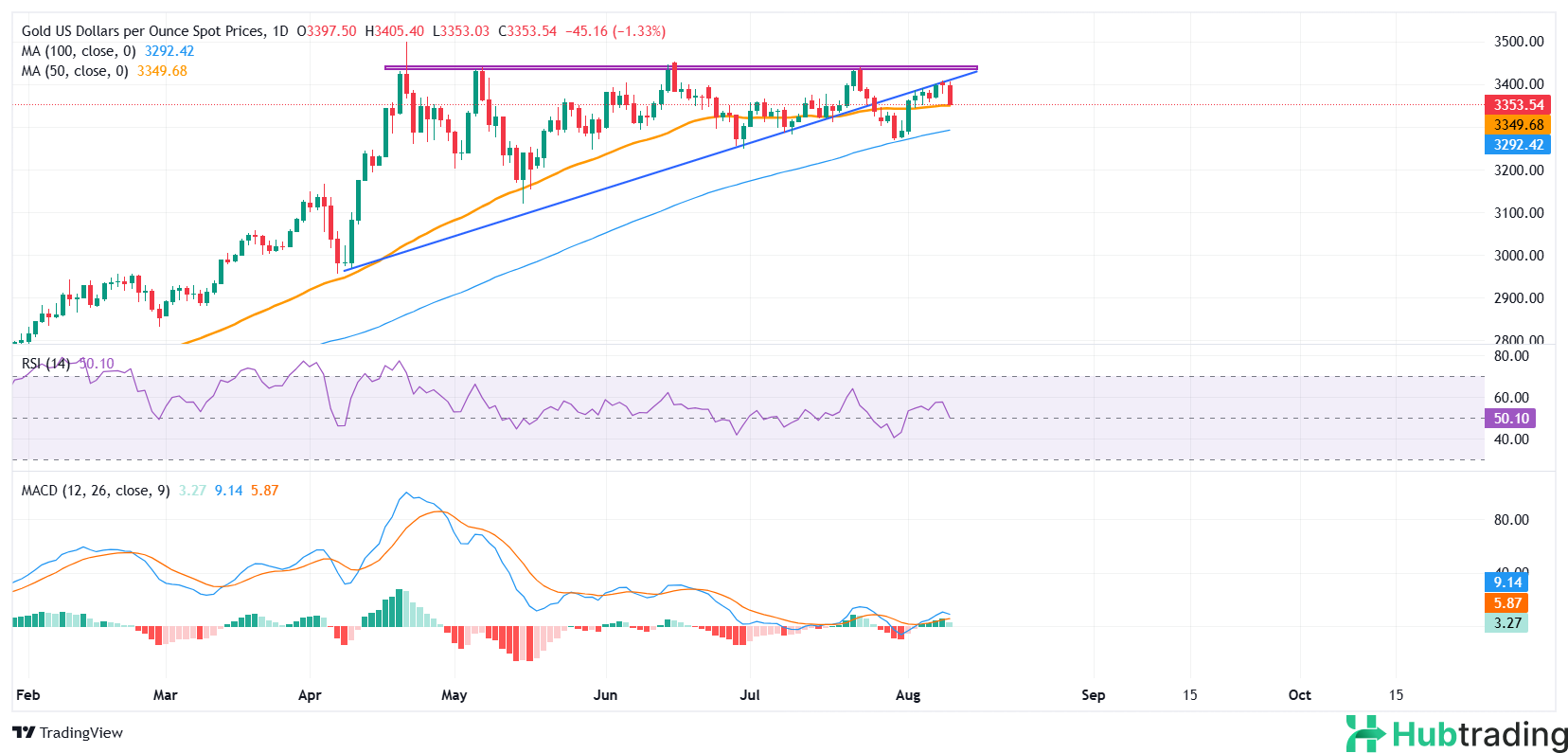-
Gold begins the week on a weaker note, pressured by stronger risk appetite and growing optimism over potential advancements in Russia-Ukraine peace talks.
-
Expectations for a Federal Reserve rate cut remain solid, with markets pricing in an 87% probability of a 25 basis point reduction in September.
-
Market uncertainty around gold eases following the White House’s announcement of an upcoming executive order aimed at countering “misinformation” related to tariffs.
Gold (XAU/USD) starts the week under pressure, trading lower on Monday as waning safe-haven demand and stronger risk appetite weigh on the precious metal. Optimism surrounding diplomatic progress in easing Russia-Ukraine tensions, coupled with gains in global equity markets, has reduced demand for bullion as investors pivot toward riskier assets.
As of writing, gold is hovering near $3,345 during the U.S. session, down nearly 1.50% on the day, after multiple failed attempts last week to break above the key $3,400 psychological level.
Investor sentiment has improved following fresh diplomatic developments over the weekend. U.S. President Donald Trump announced plans to meet Russian President Vladimir Putin on August 15 in Alaska to negotiate an end to the Ukraine conflict.
Despite the downward pressure, gold’s losses may be cushioned by firm expectations of a Federal Reserve interest rate cut in September. This outlook has kept the U.S. Dollar and Treasury yields subdued, providing a degree of support for the metal.
The CME FedWatch Tool shows markets are pricing in an 88% chance of a 25 basis-point rate cut next month, highlighting growing confidence in a more dovish Fed stance amid signs of a cooling labor market.
Market Movers: Geopolitical Tensions, Inflation Data, and the Fed Take Center Stage
- The US Dollar Index (DXY), which measures the Greenback against a basket of six major currencies, is hovering near a two-week low, showing limited movement in recent sessions. The index remains stable above the 98.00 mark, last seen around 98.60.
- US Treasury yields held steady on Monday, pausing a four-day advance. The benchmark 10-year yield hovered around 4.262%, while the 30-year yield slipped to approximately 4.825%, ending a three-day winning streak.
- Global equities began the week on a firmer note, buoyed by hopes of progress in US-Russia peace negotiations and upbeat corporate earnings. Japan’s Nikkei 225 surged 1.85% on Friday, with futures approaching record highs. European stocks opened higher on Monday but quickly gave back gains amid lingering trade and geopolitical concerns. The UK’s FTSE 100 edged up 0.26% to around 9,118, while India’s Sensex closed 746 points higher at 80,604.
- On the trade front, US reciprocal tariffs officially went into effect on August 7, lifting the overall US tariff rate to a near-century high of 18.6%, affecting over 60 trading partners. Meanwhile, the 90-day US-China tariff truce is set to expire on Tuesday, and markets await President Trump’s decision on whether to extend the agreement to allow more time for negotiations.
- Last week, market nerves were tested after reports suggested that new US tariffs could be applied to popular Swiss Gold bars, including the 1-kg and 100-ounce varieties. The uncertainty rattled the bullion market amid fears of supply chain disruptions. However, concerns were eased after the White House announced plans to issue an executive order clarifying that Gold bars would be exempt from these duties. Investors now await formal confirmation.
- Ahead of the August 15 Trump-Putin summit, major differences remain. Russia is pushing for recognition of annexed territories, Ukrainian neutrality, and the lifting of sanctions. In contrast, Ukraine demands a full ceasefire, the return of all its territory, and firm security guarantees. These opposing positions could complicate negotiations, despite a recent diplomatic thaw. A White House official confirmed that while President Trump is open to a possible trilateral summit with Presidents Putin and Zelenskyy, the current plan is for a bilateral meeting, as requested by Moscow.
- Over the past week, Federal Reserve officials have highlighted signs of a cooling economy and a softening labor market. Vice Chair Michelle Bowman, speaking on Saturday, expressed support for a September rate cut and advocated for three total cuts this year, calling the July hold a missed opportunity. Minneapolis Fed President Neel Kashkari and San Francisco Fed President Mary Daly have also indicated backing for up to two cuts this year.
- With no major US data scheduled for Monday, market focus turns to a packed economic calendar later in the week. Key releases include the Consumer Price Index (CPI) on Tuesday, the Producer Price Index (PPI) on Thursday, and Retail Sales and the preliminary August reading of the Michigan Consumer Sentiment Index on Friday. These figures will be critical for assessing inflation trends and shaping expectations for a potential Fed rate cut in September.
Technical Analysis: XAU/USD Under Pressure as $3,350 Support Comes into Focus
Gold (XAU/USD) remains under pressure at the start of the week, extending losses after repeatedly failing to break above the crucial $3,400 psychological resistance last week.
On the daily chart, the metal is encountering selling pressure near the rising trendline of an ascending triangle pattern. While a brief downside break occurred in late July, the broader bullish structure remained intact due to the lack of follow-through. However, the latest rejection from this trendline suggests that bulls are losing momentum.
Immediate support lies at the 50-day Simple Moving Average (SMA), around $3,350. A clear break below this level could pave the way toward the 100-day SMA at $3,292, followed by stronger horizontal support near the $3,250 zone.
On the upside, $3,400 continues to serve as the initial resistance level. A sustained move above this barrier could trigger further gains toward the all-time high near $3,500.
The Relative Strength Index (RSI) has slipped to the neutral 50 level, reflecting a lack of strong directional bias. Meanwhile, the Moving Average Convergence Divergence (MACD) still shows a slight bullish tilt, although narrowing histogram bars indicate fading buying pressure.






